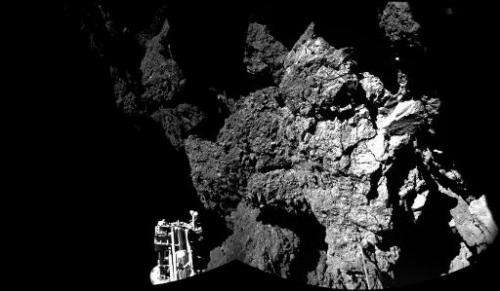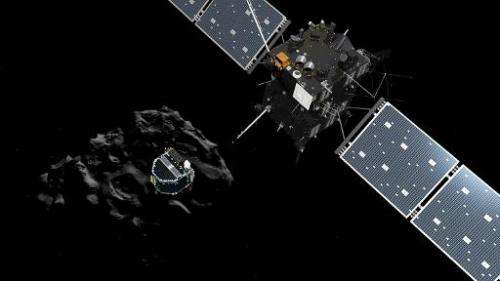Scary times for Europe's comet-chaser Rosetta (Update)

Europe's pioneering probe Rosetta battled breakdowns with navigation and communication with Earth after it ran into blasts of dust and gas from the comet it is tracking, mission control said Thursday.
Swooping close to Comet 67P/Churyumov-Gerasimenko, Rosetta "experienced significant difficulties" last weekend, the European Space Agency (ESA) said.
"The spacecraft has now been successfully recovered, but it will take a little longer to resume normal scientific operations," ESA said in a blog.
On its Twitter feed, Rosetta said, "Had some difficulties... thanks for kind messages. I'm feeling much better & hoping to resume normal activities soon!"
Behind the official statements, though, it was clear the 1.3-billion-euro ($1.4-billion) mission had had some heart-stopping moments.
"Rosetta won't be going so close (to the comet) again," said operations manager Sylvain Lodiot, who said his team had had a sleepless weekend.
Rosetta has been circling "67P/C-G" since last August, catching up with the wanderer after a 10-year, 6.5-billion-kilometer (four-billion-mile) chase across the heavens.
The mission seeks to unveil the secrets of comets, believed to be time capsules from the birth of the Solar System.
The target comet is getting closer to the Sun with every second, and the solar heat is causing its surface to warm.
This in turn is causing dust to be stripped away and gases to heat and blast out into space.
It is this spectacular show that, with luck, can be seen from Earth as a fiery "coma" when a comet passes close by.
For Rosetta, though, the outpouring was a problem on an unexpected scale, as the orbiter raced to within 14 kilometres of the surface.

Flying through dense, outflowing gas and dust exposed the spacecraft's solar panels, like outstretched wings, to drag.
Another problem was that Rosetta is designed to navigate by locking on to the stars—and its trackers mistook hundreds of pieces of comet debris for stars.
As a result, the spacecraft began to drift and its high-gain antenna, used to send and receive signals from ground stations on Earth, started to point away from home... and communications began to falter.
"The problems began on Saturday morning and lasted until Sunday night. It was pretty hairy stuff," said Lodiot, in charge of Rosetta's operations at ESA's facility in Darmstadt, Germany.
"On Sunday morning, we were losing communications with Rosetta. I watched the signal fade bit by bit. It was dramatic," Lodiot told AFP by phone.
Rosetta then automatically placed itself into safe mode, turning off all instruments to try to keep in touch with the distant Earth.
"Fortunately, the star trackers came back online when the probe was about 75 kilometres from the comet" and the craft was able to find its position once more, Lodiot said.
By Monday, ground teams had brought Rosetta back to normal status.
"The spacecraft is in perfect shape. It did not suffer any damage," Lodiot said.
Rosetta is now at a safer distance of 400 km from the comet, and will be brought back to within 100 km, Lodiot said.
Months of work wasted
However, future flybys will have to be reassessed to take into account the dust and gas peril, which is likely to worsen as the comet heads towards perihelion, its closest point to the Sun.
"Months of work (on planning the trajectories) will have to be binned," Lodiot lamented.
The changes also mean that Rosetta's science programme—the craft is scanning the comet with 11 instruments—will need to be reviewed.
On November 12, Rosetta sent down a fridge-sized robot lab, Philae, which carried out a 54-hour roster of experiments before its battery ran out of power.
The lander is believed to be in the shadow of a cliff, preventing its solar panels from getting enough sunlight to power up. The mission hopes Philae will revive as 67/P gets closer to the Sun.
Rosetta on Thursday was 423 million km from Earth and 293 million km from the Sun, according to the mission's website (sci.esa.int/where_is_rosetta/ ).
Perihelion will be on August 13, when the comet will be 186 million km from the Sun.
© 2015 AFP




















